Project Management Report: QAHE University Uganda Educational Tour
VerifiedAdded on 2023/01/06
|16
|3635
|82
Project
AI Summary
This project management report details the planning and execution of an educational tour to Uganda for QAHE University students. It begins with a Project Initiation Document outlining objectives, approach, timescale, key staff, budget, and stakeholder analysis. Task management and scheduling are presented using a Gantt chart, network diagram, and work breakdown structure. The report then addresses risk management with a risk register identifying potential risks, their probabilities, impacts, and mitigation strategies. It emphasizes the criticality of communication and team building, and concludes with a discussion of project management methodologies, including PRINCE2. The project focuses on a two-week field trip, scheduled for March, with a total duration of 45 days, aiming to provide students with practical experiences and broaden their perspectives on sustainable business practices.
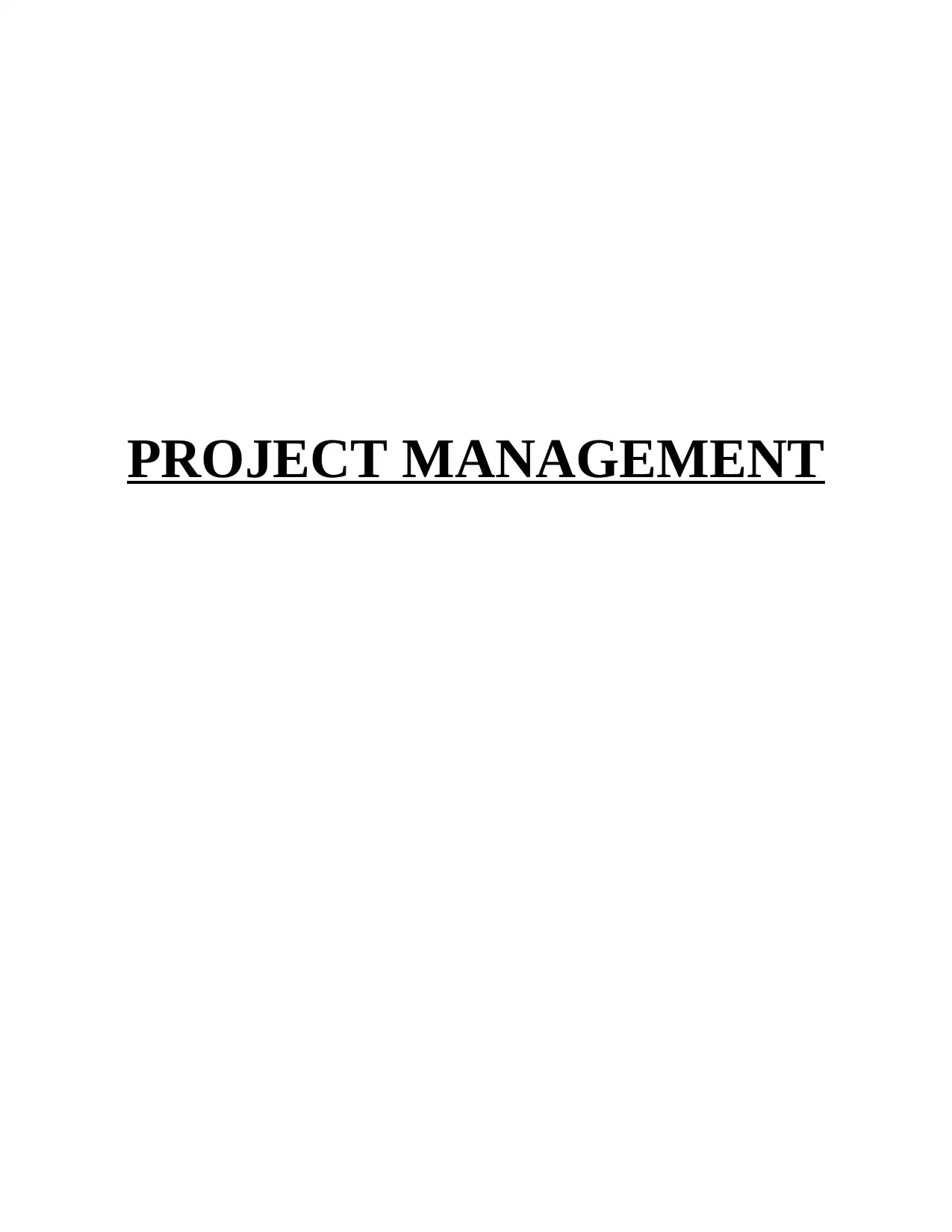
PROJECT MANAGEMENT
Paraphrase This Document
Need a fresh take? Get an instant paraphrase of this document with our AI Paraphraser
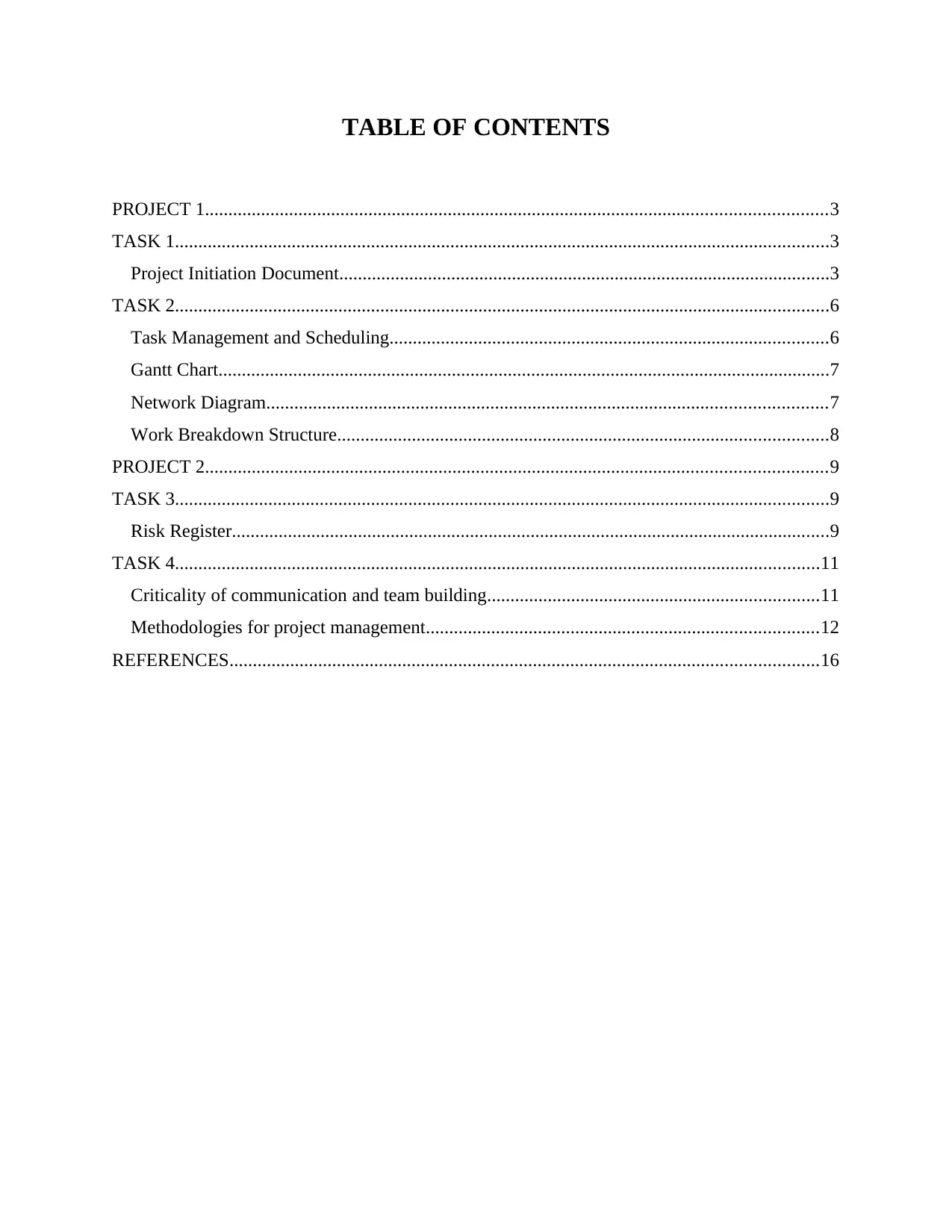
TABLE OF CONTENTS
PROJECT 1.....................................................................................................................................3
TASK 1............................................................................................................................................3
Project Initiation Document.........................................................................................................3
TASK 2............................................................................................................................................6
Task Management and Scheduling..............................................................................................6
Gantt Chart...................................................................................................................................7
Network Diagram........................................................................................................................7
Work Breakdown Structure.........................................................................................................8
PROJECT 2.....................................................................................................................................9
TASK 3............................................................................................................................................9
Risk Register................................................................................................................................9
TASK 4..........................................................................................................................................11
Criticality of communication and team building.......................................................................11
Methodologies for project management....................................................................................12
REFERENCES..............................................................................................................................16
PROJECT 1.....................................................................................................................................3
TASK 1............................................................................................................................................3
Project Initiation Document.........................................................................................................3
TASK 2............................................................................................................................................6
Task Management and Scheduling..............................................................................................6
Gantt Chart...................................................................................................................................7
Network Diagram........................................................................................................................7
Work Breakdown Structure.........................................................................................................8
PROJECT 2.....................................................................................................................................9
TASK 3............................................................................................................................................9
Risk Register................................................................................................................................9
TASK 4..........................................................................................................................................11
Criticality of communication and team building.......................................................................11
Methodologies for project management....................................................................................12
REFERENCES..............................................................................................................................16
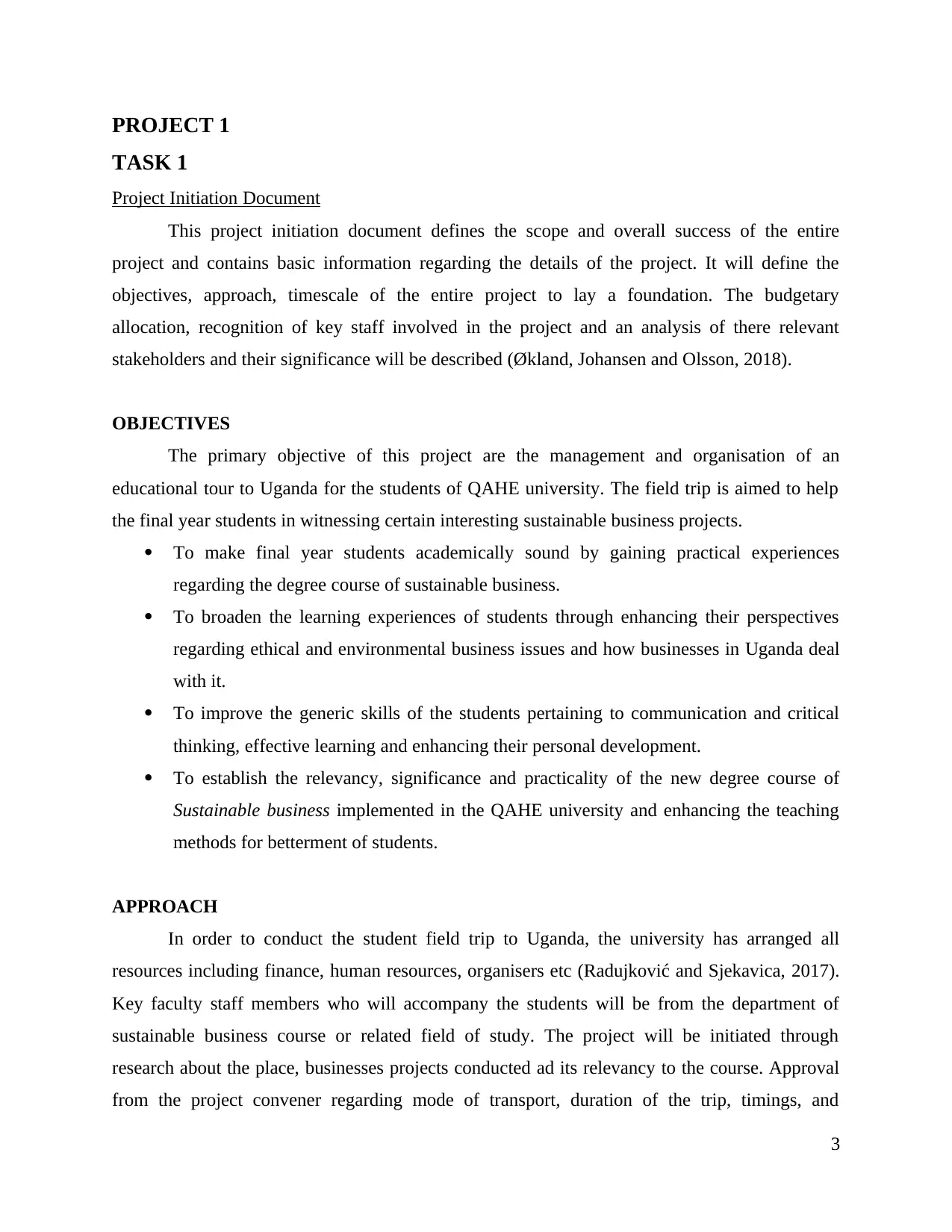
PROJECT 1
TASK 1
Project Initiation Document
This project initiation document defines the scope and overall success of the entire
project and contains basic information regarding the details of the project. It will define the
objectives, approach, timescale of the entire project to lay a foundation. The budgetary
allocation, recognition of key staff involved in the project and an analysis of there relevant
stakeholders and their significance will be described (Økland, Johansen and Olsson, 2018).
OBJECTIVES
The primary objective of this project are the management and organisation of an
educational tour to Uganda for the students of QAHE university. The field trip is aimed to help
the final year students in witnessing certain interesting sustainable business projects.
To make final year students academically sound by gaining practical experiences
regarding the degree course of sustainable business.
To broaden the learning experiences of students through enhancing their perspectives
regarding ethical and environmental business issues and how businesses in Uganda deal
with it.
To improve the generic skills of the students pertaining to communication and critical
thinking, effective learning and enhancing their personal development.
To establish the relevancy, significance and practicality of the new degree course of
Sustainable business implemented in the QAHE university and enhancing the teaching
methods for betterment of students.
APPROACH
In order to conduct the student field trip to Uganda, the university has arranged all
resources including finance, human resources, organisers etc (Radujković and Sjekavica, 2017).
Key faculty staff members who will accompany the students will be from the department of
sustainable business course or related field of study. The project will be initiated through
research about the place, businesses projects conducted ad its relevancy to the course. Approval
from the project convener regarding mode of transport, duration of the trip, timings, and
3
TASK 1
Project Initiation Document
This project initiation document defines the scope and overall success of the entire
project and contains basic information regarding the details of the project. It will define the
objectives, approach, timescale of the entire project to lay a foundation. The budgetary
allocation, recognition of key staff involved in the project and an analysis of there relevant
stakeholders and their significance will be described (Økland, Johansen and Olsson, 2018).
OBJECTIVES
The primary objective of this project are the management and organisation of an
educational tour to Uganda for the students of QAHE university. The field trip is aimed to help
the final year students in witnessing certain interesting sustainable business projects.
To make final year students academically sound by gaining practical experiences
regarding the degree course of sustainable business.
To broaden the learning experiences of students through enhancing their perspectives
regarding ethical and environmental business issues and how businesses in Uganda deal
with it.
To improve the generic skills of the students pertaining to communication and critical
thinking, effective learning and enhancing their personal development.
To establish the relevancy, significance and practicality of the new degree course of
Sustainable business implemented in the QAHE university and enhancing the teaching
methods for betterment of students.
APPROACH
In order to conduct the student field trip to Uganda, the university has arranged all
resources including finance, human resources, organisers etc (Radujković and Sjekavica, 2017).
Key faculty staff members who will accompany the students will be from the department of
sustainable business course or related field of study. The project will be initiated through
research about the place, businesses projects conducted ad its relevancy to the course. Approval
from the project convener regarding mode of transport, duration of the trip, timings, and
3
⊘ This is a preview!⊘
Do you want full access?
Subscribe today to unlock all pages.

Trusted by 1+ million students worldwide
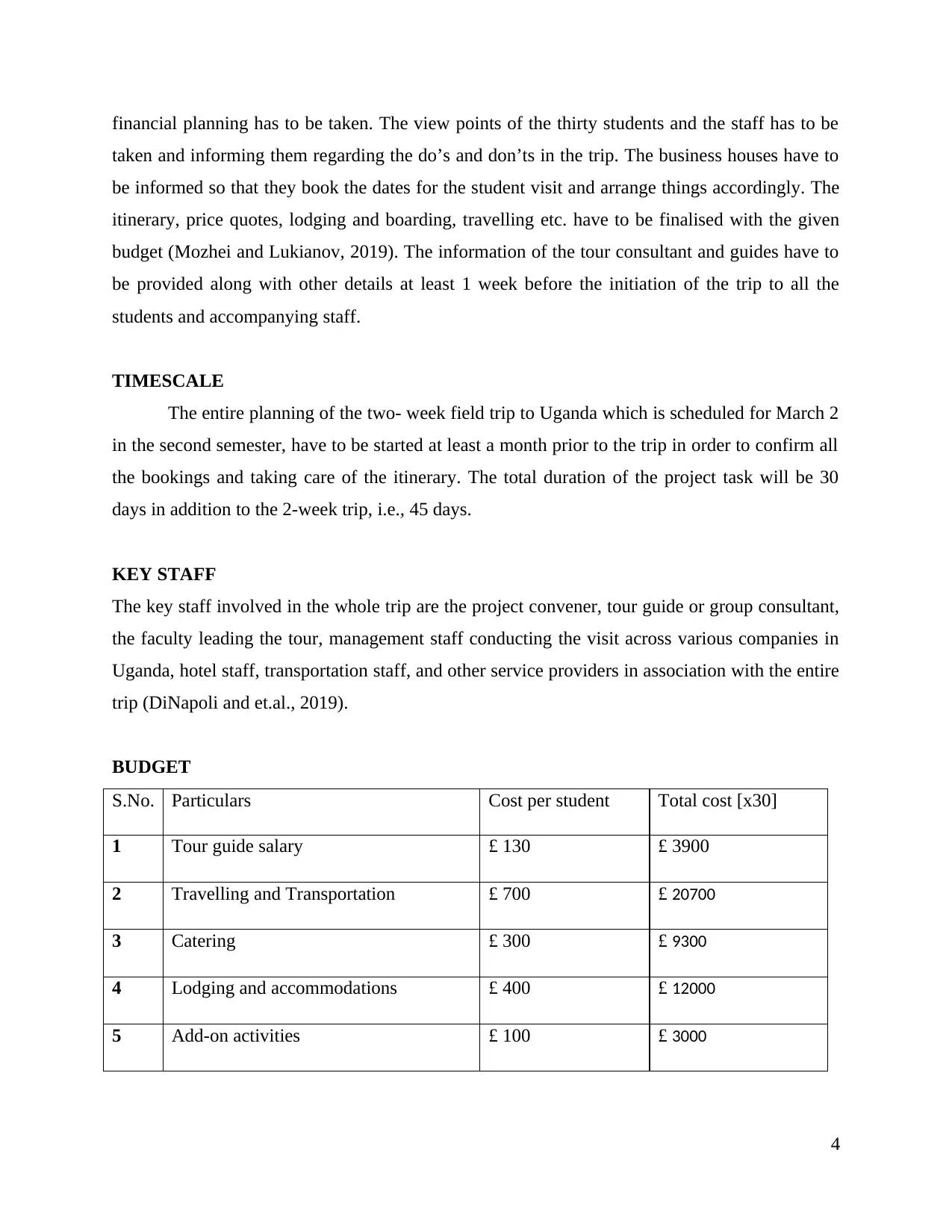
financial planning has to be taken. The view points of the thirty students and the staff has to be
taken and informing them regarding the do’s and don’ts in the trip. The business houses have to
be informed so that they book the dates for the student visit and arrange things accordingly. The
itinerary, price quotes, lodging and boarding, travelling etc. have to be finalised with the given
budget (Mozhei and Lukianov, 2019). The information of the tour consultant and guides have to
be provided along with other details at least 1 week before the initiation of the trip to all the
students and accompanying staff.
TIMESCALE
The entire planning of the two- week field trip to Uganda which is scheduled for March 2
in the second semester, have to be started at least a month prior to the trip in order to confirm all
the bookings and taking care of the itinerary. The total duration of the project task will be 30
days in addition to the 2-week trip, i.e., 45 days.
KEY STAFF
The key staff involved in the whole trip are the project convener, tour guide or group consultant,
the faculty leading the tour, management staff conducting the visit across various companies in
Uganda, hotel staff, transportation staff, and other service providers in association with the entire
trip (DiNapoli and et.al., 2019).
BUDGET
S.No. Particulars Cost per student Total cost [x30]
1 Tour guide salary £ 130 £ 3900
2 Travelling and Transportation £ 700 £ 20700
3 Catering £ 300 £ 9300
4 Lodging and accommodations £ 400 £ 12000
5 Add-on activities £ 100 £ 3000
4
taken and informing them regarding the do’s and don’ts in the trip. The business houses have to
be informed so that they book the dates for the student visit and arrange things accordingly. The
itinerary, price quotes, lodging and boarding, travelling etc. have to be finalised with the given
budget (Mozhei and Lukianov, 2019). The information of the tour consultant and guides have to
be provided along with other details at least 1 week before the initiation of the trip to all the
students and accompanying staff.
TIMESCALE
The entire planning of the two- week field trip to Uganda which is scheduled for March 2
in the second semester, have to be started at least a month prior to the trip in order to confirm all
the bookings and taking care of the itinerary. The total duration of the project task will be 30
days in addition to the 2-week trip, i.e., 45 days.
KEY STAFF
The key staff involved in the whole trip are the project convener, tour guide or group consultant,
the faculty leading the tour, management staff conducting the visit across various companies in
Uganda, hotel staff, transportation staff, and other service providers in association with the entire
trip (DiNapoli and et.al., 2019).
BUDGET
S.No. Particulars Cost per student Total cost [x30]
1 Tour guide salary £ 130 £ 3900
2 Travelling and Transportation £ 700 £ 20700
3 Catering £ 300 £ 9300
4 Lodging and accommodations £ 400 £ 12000
5 Add-on activities £ 100 £ 3000
4
Paraphrase This Document
Need a fresh take? Get an instant paraphrase of this document with our AI Paraphraser
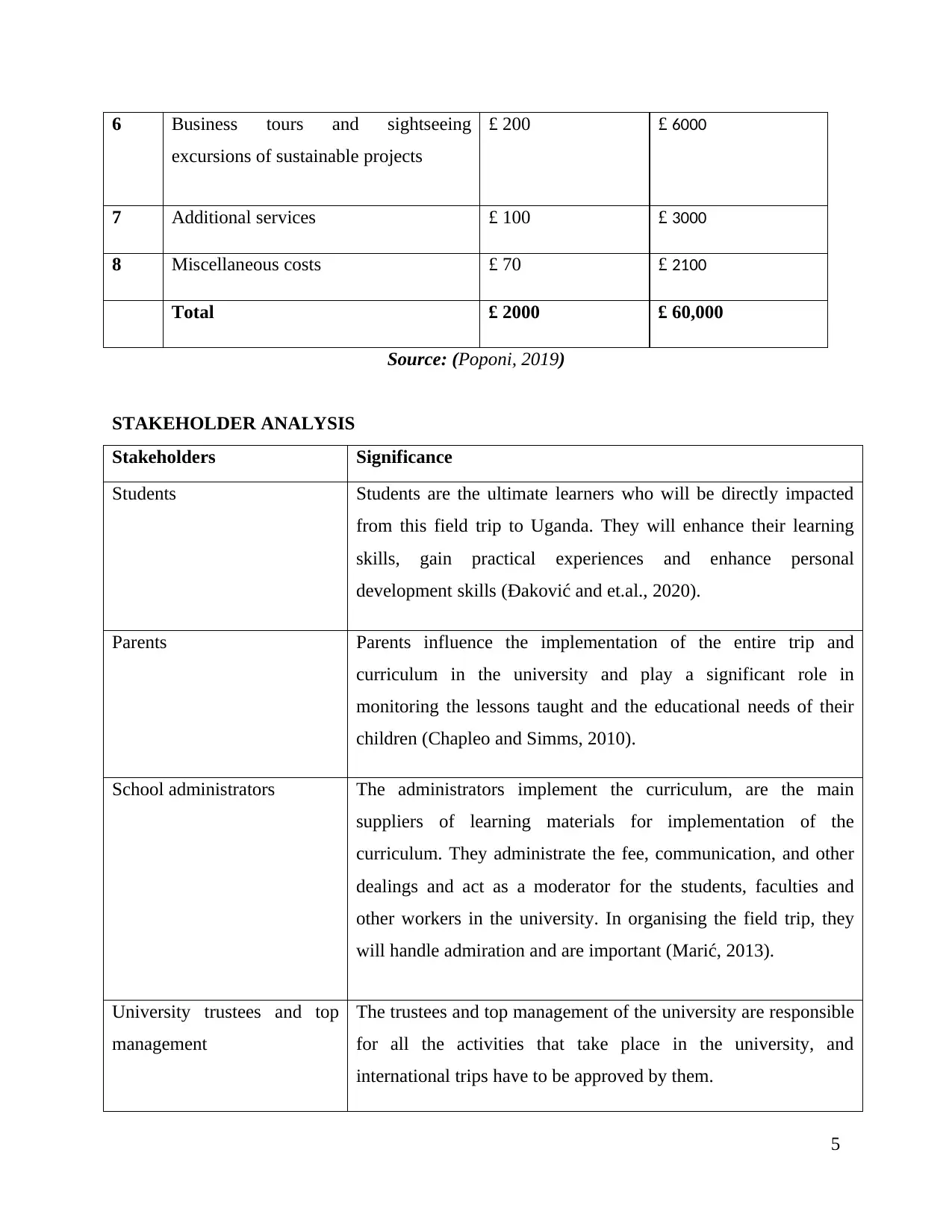
6 Business tours and sightseeing
excursions of sustainable projects
£ 200 £ 6000
7 Additional services £ 100 £ 3000
8 Miscellaneous costs £ 70 £ 2100
Total £ 2000 £ 60,000
Source: (Poponi, 2019)
STAKEHOLDER ANALYSIS
Stakeholders Significance
Students Students are the ultimate learners who will be directly impacted
from this field trip to Uganda. They will enhance their learning
skills, gain practical experiences and enhance personal
development skills (Đaković and et.al., 2020).
Parents Parents influence the implementation of the entire trip and
curriculum in the university and play a significant role in
monitoring the lessons taught and the educational needs of their
children (Chapleo and Simms, 2010).
School administrators The administrators implement the curriculum, are the main
suppliers of learning materials for implementation of the
curriculum. They administrate the fee, communication, and other
dealings and act as a moderator for the students, faculties and
other workers in the university. In organising the field trip, they
will handle admiration and are important (Marić, 2013).
University trustees and top
management
The trustees and top management of the university are responsible
for all the activities that take place in the university, and
international trips have to be approved by them.
5
excursions of sustainable projects
£ 200 £ 6000
7 Additional services £ 100 £ 3000
8 Miscellaneous costs £ 70 £ 2100
Total £ 2000 £ 60,000
Source: (Poponi, 2019)
STAKEHOLDER ANALYSIS
Stakeholders Significance
Students Students are the ultimate learners who will be directly impacted
from this field trip to Uganda. They will enhance their learning
skills, gain practical experiences and enhance personal
development skills (Đaković and et.al., 2020).
Parents Parents influence the implementation of the entire trip and
curriculum in the university and play a significant role in
monitoring the lessons taught and the educational needs of their
children (Chapleo and Simms, 2010).
School administrators The administrators implement the curriculum, are the main
suppliers of learning materials for implementation of the
curriculum. They administrate the fee, communication, and other
dealings and act as a moderator for the students, faculties and
other workers in the university. In organising the field trip, they
will handle admiration and are important (Marić, 2013).
University trustees and top
management
The trustees and top management of the university are responsible
for all the activities that take place in the university, and
international trips have to be approved by them.
5
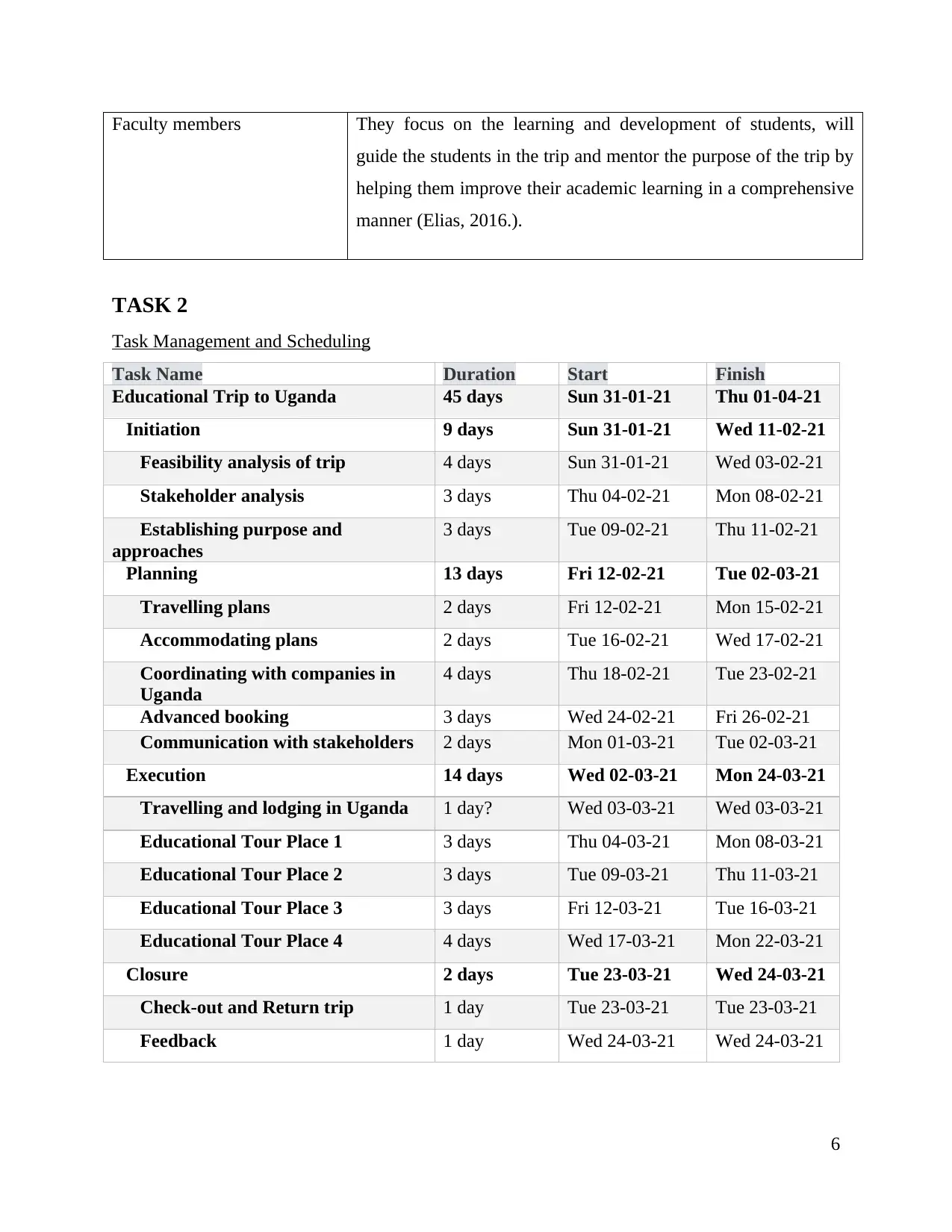
Faculty members They focus on the learning and development of students, will
guide the students in the trip and mentor the purpose of the trip by
helping them improve their academic learning in a comprehensive
manner (Elias, 2016.).
TASK 2
Task Management and Scheduling
Task Name Duration Start Finish
Educational Trip to Uganda 45 days Sun 31-01-21 Thu 01-04-21
Initiation 9 days Sun 31-01-21 Wed 11-02-21
Feasibility analysis of trip 4 days Sun 31-01-21 Wed 03-02-21
Stakeholder analysis 3 days Thu 04-02-21 Mon 08-02-21
Establishing purpose and
approaches
3 days Tue 09-02-21 Thu 11-02-21
Planning 13 days Fri 12-02-21 Tue 02-03-21
Travelling plans 2 days Fri 12-02-21 Mon 15-02-21
Accommodating plans 2 days Tue 16-02-21 Wed 17-02-21
Coordinating with companies in
Uganda
4 days Thu 18-02-21 Tue 23-02-21
Advanced booking 3 days Wed 24-02-21 Fri 26-02-21
Communication with stakeholders 2 days Mon 01-03-21 Tue 02-03-21
Execution 14 days Wed 02-03-21 Mon 24-03-21
Travelling and lodging in Uganda 1 day? Wed 03-03-21 Wed 03-03-21
Educational Tour Place 1 3 days Thu 04-03-21 Mon 08-03-21
Educational Tour Place 2 3 days Tue 09-03-21 Thu 11-03-21
Educational Tour Place 3 3 days Fri 12-03-21 Tue 16-03-21
Educational Tour Place 4 4 days Wed 17-03-21 Mon 22-03-21
Closure 2 days Tue 23-03-21 Wed 24-03-21
Check-out and Return trip 1 day Tue 23-03-21 Tue 23-03-21
Feedback 1 day Wed 24-03-21 Wed 24-03-21
6
guide the students in the trip and mentor the purpose of the trip by
helping them improve their academic learning in a comprehensive
manner (Elias, 2016.).
TASK 2
Task Management and Scheduling
Task Name Duration Start Finish
Educational Trip to Uganda 45 days Sun 31-01-21 Thu 01-04-21
Initiation 9 days Sun 31-01-21 Wed 11-02-21
Feasibility analysis of trip 4 days Sun 31-01-21 Wed 03-02-21
Stakeholder analysis 3 days Thu 04-02-21 Mon 08-02-21
Establishing purpose and
approaches
3 days Tue 09-02-21 Thu 11-02-21
Planning 13 days Fri 12-02-21 Tue 02-03-21
Travelling plans 2 days Fri 12-02-21 Mon 15-02-21
Accommodating plans 2 days Tue 16-02-21 Wed 17-02-21
Coordinating with companies in
Uganda
4 days Thu 18-02-21 Tue 23-02-21
Advanced booking 3 days Wed 24-02-21 Fri 26-02-21
Communication with stakeholders 2 days Mon 01-03-21 Tue 02-03-21
Execution 14 days Wed 02-03-21 Mon 24-03-21
Travelling and lodging in Uganda 1 day? Wed 03-03-21 Wed 03-03-21
Educational Tour Place 1 3 days Thu 04-03-21 Mon 08-03-21
Educational Tour Place 2 3 days Tue 09-03-21 Thu 11-03-21
Educational Tour Place 3 3 days Fri 12-03-21 Tue 16-03-21
Educational Tour Place 4 4 days Wed 17-03-21 Mon 22-03-21
Closure 2 days Tue 23-03-21 Wed 24-03-21
Check-out and Return trip 1 day Tue 23-03-21 Tue 23-03-21
Feedback 1 day Wed 24-03-21 Wed 24-03-21
6
⊘ This is a preview!⊘
Do you want full access?
Subscribe today to unlock all pages.

Trusted by 1+ million students worldwide
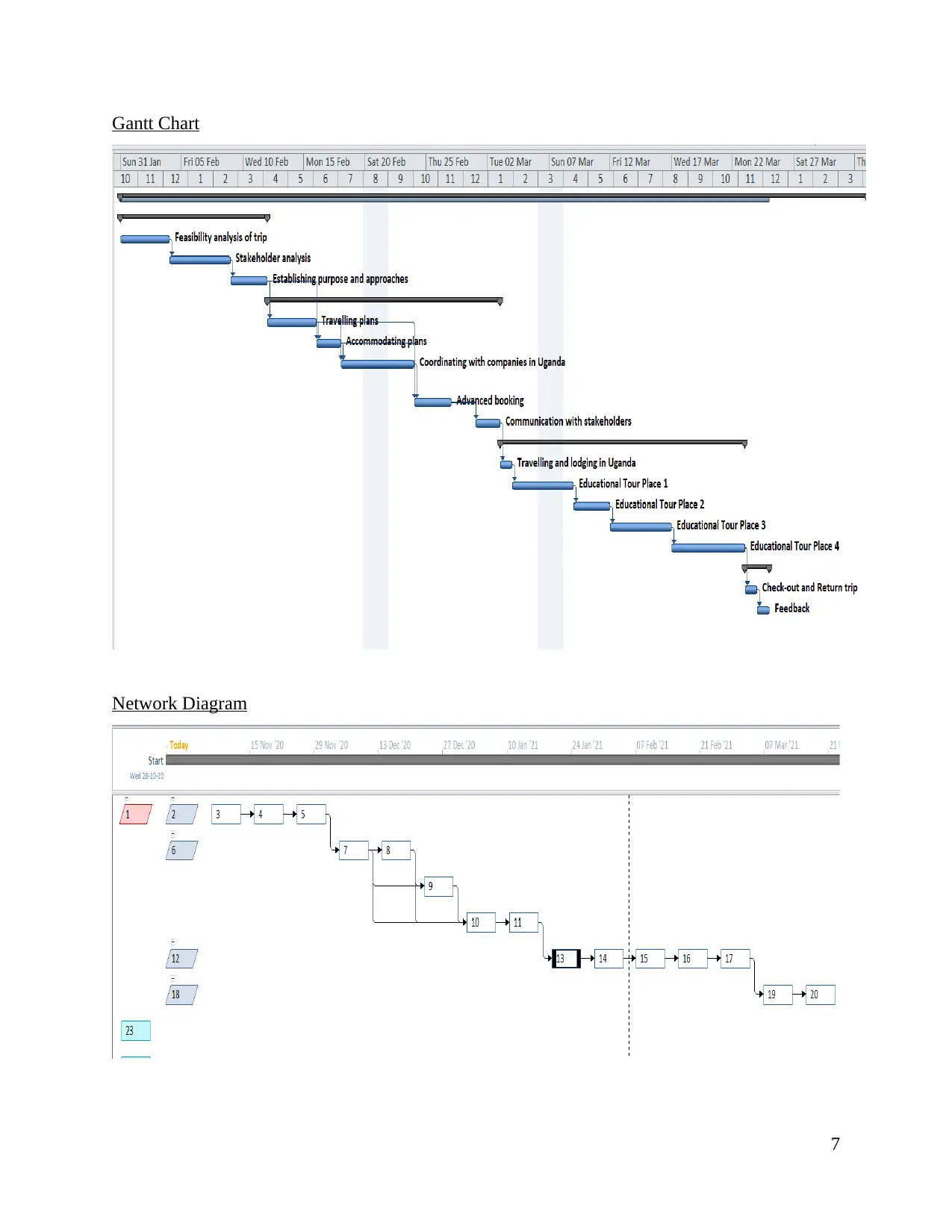
Gantt Chart
Network Diagram
7
Network Diagram
7
Paraphrase This Document
Need a fresh take? Get an instant paraphrase of this document with our AI Paraphraser
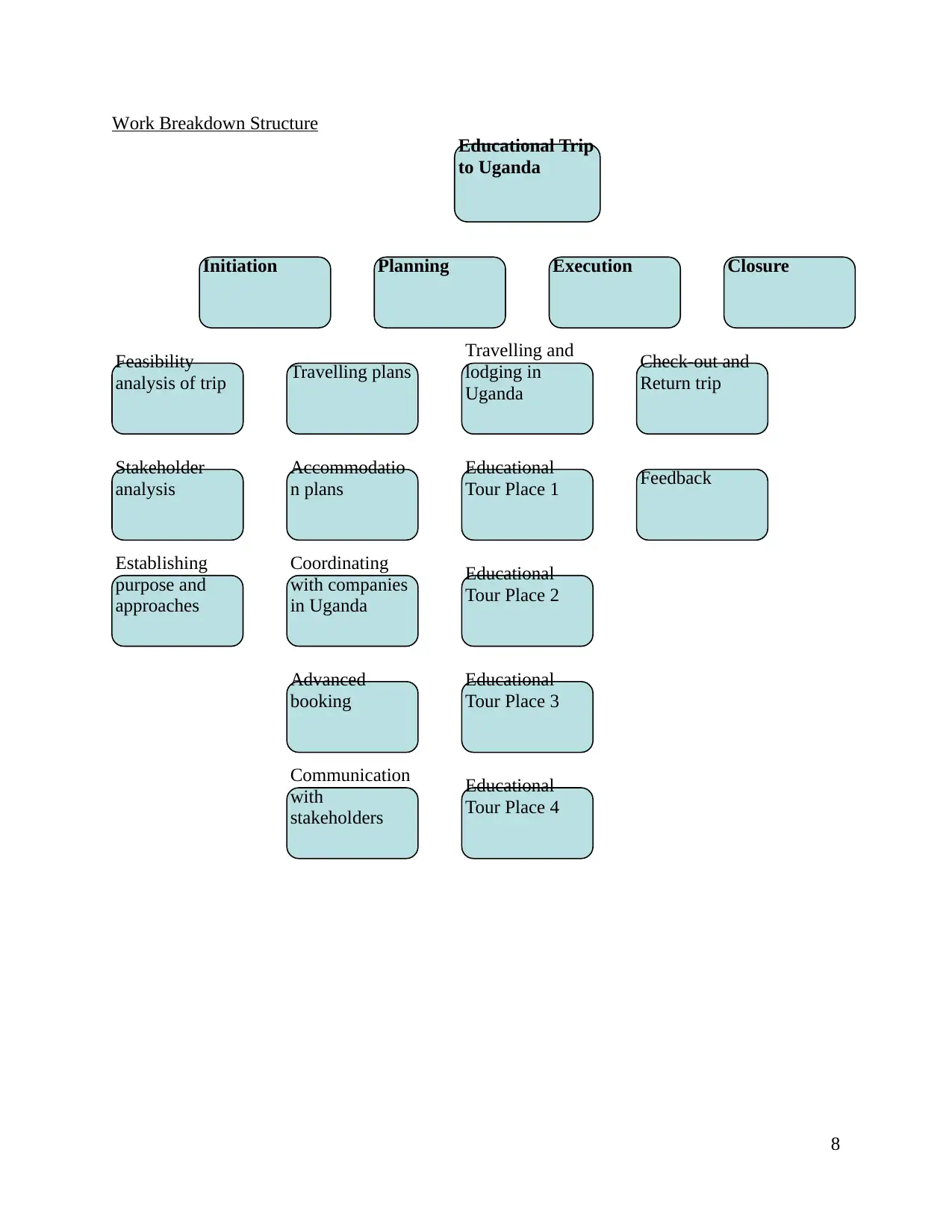
Work Breakdown Structure
8
Educational Trip
to Uganda
Initiation Planning Execution Closure
Feasibility
analysis of trip
Stakeholder
analysis
Travelling plans
Establishing
purpose and
approaches
Accommodatio
n plans
Coordinating
with companies
in Uganda
Advanced
booking
Communication
with
stakeholders
Travelling and
lodging in
Uganda
Educational
Tour Place 1
Educational
Tour Place 2
Educational
Tour Place 3
Educational
Tour Place 4
Check-out and
Return trip
Feedback
8
Educational Trip
to Uganda
Initiation Planning Execution Closure
Feasibility
analysis of trip
Stakeholder
analysis
Travelling plans
Establishing
purpose and
approaches
Accommodatio
n plans
Coordinating
with companies
in Uganda
Advanced
booking
Communication
with
stakeholders
Travelling and
lodging in
Uganda
Educational
Tour Place 1
Educational
Tour Place 2
Educational
Tour Place 3
Educational
Tour Place 4
Check-out and
Return trip
Feedback
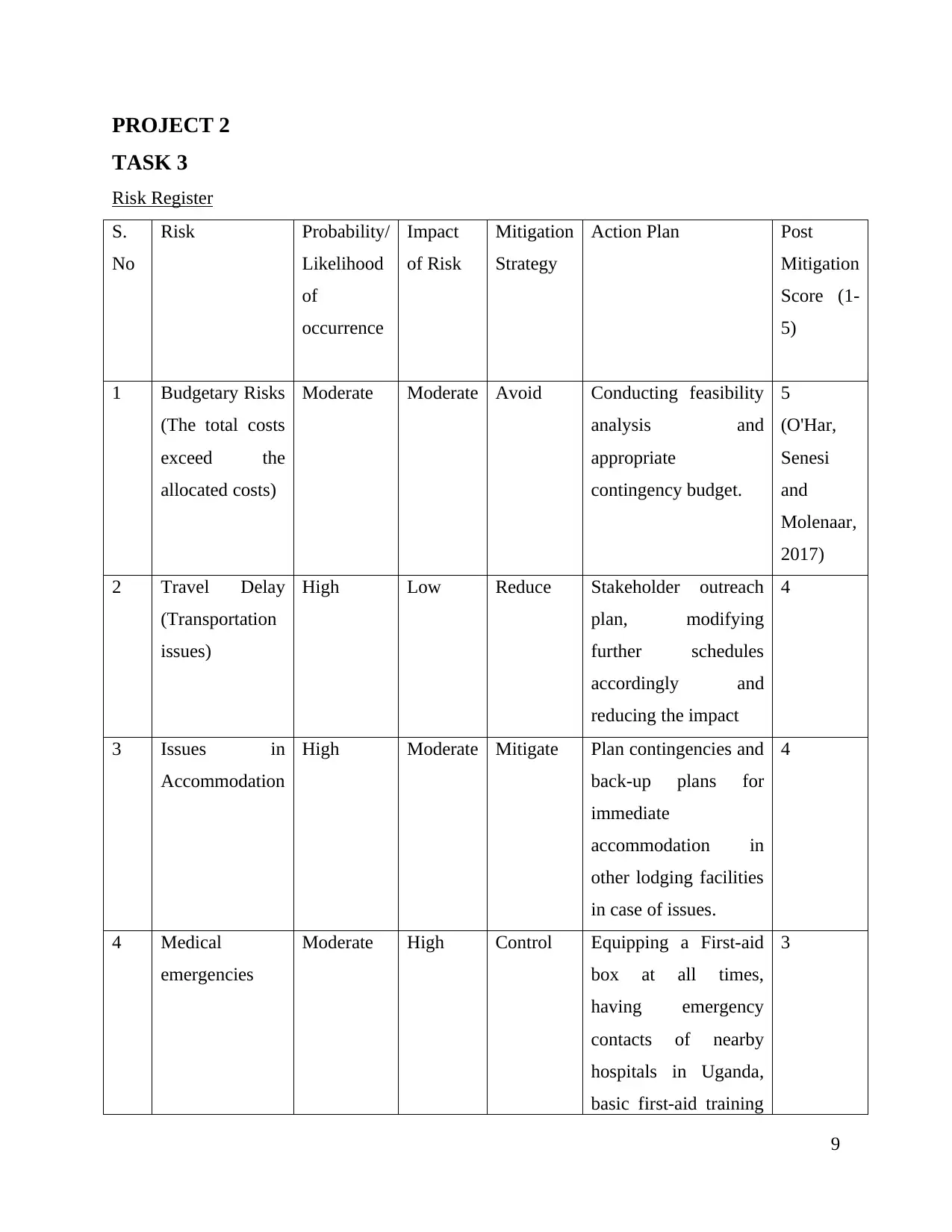
PROJECT 2
TASK 3
Risk Register
S.
No
Risk Probability/
Likelihood
of
occurrence
Impact
of Risk
Mitigation
Strategy
Action Plan Post
Mitigation
Score (1-
5)
1 Budgetary Risks
(The total costs
exceed the
allocated costs)
Moderate Moderate Avoid Conducting feasibility
analysis and
appropriate
contingency budget.
5
(O'Har,
Senesi
and
Molenaar,
2017)
2 Travel Delay
(Transportation
issues)
High Low Reduce Stakeholder outreach
plan, modifying
further schedules
accordingly and
reducing the impact
4
3 Issues in
Accommodation
High Moderate Mitigate Plan contingencies and
back-up plans for
immediate
accommodation in
other lodging facilities
in case of issues.
4
4 Medical
emergencies
Moderate High Control Equipping a First-aid
box at all times,
having emergency
contacts of nearby
hospitals in Uganda,
basic first-aid training
3
9
TASK 3
Risk Register
S.
No
Risk Probability/
Likelihood
of
occurrence
Impact
of Risk
Mitigation
Strategy
Action Plan Post
Mitigation
Score (1-
5)
1 Budgetary Risks
(The total costs
exceed the
allocated costs)
Moderate Moderate Avoid Conducting feasibility
analysis and
appropriate
contingency budget.
5
(O'Har,
Senesi
and
Molenaar,
2017)
2 Travel Delay
(Transportation
issues)
High Low Reduce Stakeholder outreach
plan, modifying
further schedules
accordingly and
reducing the impact
4
3 Issues in
Accommodation
High Moderate Mitigate Plan contingencies and
back-up plans for
immediate
accommodation in
other lodging facilities
in case of issues.
4
4 Medical
emergencies
Moderate High Control Equipping a First-aid
box at all times,
having emergency
contacts of nearby
hospitals in Uganda,
basic first-aid training
3
9
⊘ This is a preview!⊘
Do you want full access?
Subscribe today to unlock all pages.

Trusted by 1+ million students worldwide
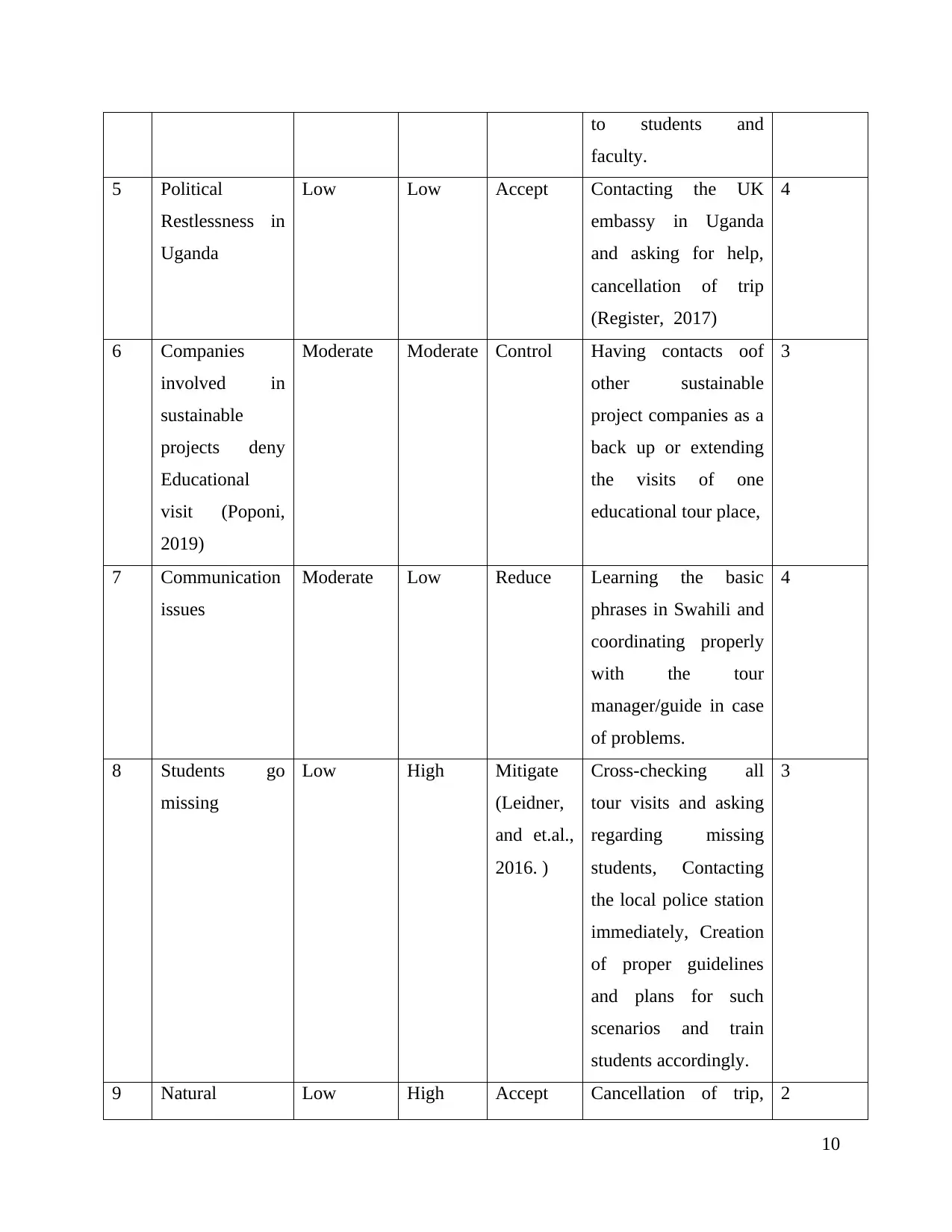
to students and
faculty.
5 Political
Restlessness in
Uganda
Low Low Accept Contacting the UK
embassy in Uganda
and asking for help,
cancellation of trip
(Register, 2017)
4
6 Companies
involved in
sustainable
projects deny
Educational
visit (Poponi,
2019)
Moderate Moderate Control Having contacts oof
other sustainable
project companies as a
back up or extending
the visits of one
educational tour place,
3
7 Communication
issues
Moderate Low Reduce Learning the basic
phrases in Swahili and
coordinating properly
with the tour
manager/guide in case
of problems.
4
8 Students go
missing
Low High Mitigate
(Leidner,
and et.al.,
2016. )
Cross-checking all
tour visits and asking
regarding missing
students, Contacting
the local police station
immediately, Creation
of proper guidelines
and plans for such
scenarios and train
students accordingly.
3
9 Natural Low High Accept Cancellation of trip, 2
10
faculty.
5 Political
Restlessness in
Uganda
Low Low Accept Contacting the UK
embassy in Uganda
and asking for help,
cancellation of trip
(Register, 2017)
4
6 Companies
involved in
sustainable
projects deny
Educational
visit (Poponi,
2019)
Moderate Moderate Control Having contacts oof
other sustainable
project companies as a
back up or extending
the visits of one
educational tour place,
3
7 Communication
issues
Moderate Low Reduce Learning the basic
phrases in Swahili and
coordinating properly
with the tour
manager/guide in case
of problems.
4
8 Students go
missing
Low High Mitigate
(Leidner,
and et.al.,
2016. )
Cross-checking all
tour visits and asking
regarding missing
students, Contacting
the local police station
immediately, Creation
of proper guidelines
and plans for such
scenarios and train
students accordingly.
3
9 Natural Low High Accept Cancellation of trip, 2
10
Paraphrase This Document
Need a fresh take? Get an instant paraphrase of this document with our AI Paraphraser

Disasters Application of safety
and disaster plans and
codes
10 Terrorist attack Low High Accept Cancellation of Trip,
Contacting the nearby
police stations, UK
embassy in Uganda
1
In project management, the purpose of a risk register is recording and documentation of
the types of risks that could impact the project in any way, ranging from low to extreme impact.
They are identified after considering all the aspects of the projects extensively and are analysed
along with the description of its probability or likelihood of occurrence and impact level. Various
mitigation strategies such as accept, reduce, mitigate, control and avoid are applied after
evaluating the risk and action plan is devised as per the strategy. The post mitigation score is
allotted for determining the effect of implementation of the mitigation strategy. The risk register
database can be beneficial for monitoring the risks and be prepared to deal with any unforeseen
circumstances otherwise. The risks in the two-week field trip to Uganda can range from low
impact to extreme, such as communication risks, budgetary risks, travel delay to terrorist attacks
ad natural disaster risks. Appropriate action plans have been devised above briefly for dealing
with the risks (Krueger, Sautner and Starks, 2020).
TASK 4
Criticality of communication and team building
Structured communication between the project manager and team members is extremely
important in successfulness and timely completion of any project as communication makes up
most part of the project. It helps everyone being in touch with the real challenges and issues
within a team for delivering the project. Clarity in communication, timelines, targets and goals,
performance requirements, expectations and feedback are notable aspects of a projects which are
moderated through communication. Many appropriate structured communication methods can be
used to organise the project of 2-week education field trip to Uganda. These include face to face
meetings, video conferencing or telephone conference for major communication that have to be
11
and disaster plans and
codes
10 Terrorist attack Low High Accept Cancellation of Trip,
Contacting the nearby
police stations, UK
embassy in Uganda
1
In project management, the purpose of a risk register is recording and documentation of
the types of risks that could impact the project in any way, ranging from low to extreme impact.
They are identified after considering all the aspects of the projects extensively and are analysed
along with the description of its probability or likelihood of occurrence and impact level. Various
mitigation strategies such as accept, reduce, mitigate, control and avoid are applied after
evaluating the risk and action plan is devised as per the strategy. The post mitigation score is
allotted for determining the effect of implementation of the mitigation strategy. The risk register
database can be beneficial for monitoring the risks and be prepared to deal with any unforeseen
circumstances otherwise. The risks in the two-week field trip to Uganda can range from low
impact to extreme, such as communication risks, budgetary risks, travel delay to terrorist attacks
ad natural disaster risks. Appropriate action plans have been devised above briefly for dealing
with the risks (Krueger, Sautner and Starks, 2020).
TASK 4
Criticality of communication and team building
Structured communication between the project manager and team members is extremely
important in successfulness and timely completion of any project as communication makes up
most part of the project. It helps everyone being in touch with the real challenges and issues
within a team for delivering the project. Clarity in communication, timelines, targets and goals,
performance requirements, expectations and feedback are notable aspects of a projects which are
moderated through communication. Many appropriate structured communication methods can be
used to organise the project of 2-week education field trip to Uganda. These include face to face
meetings, video conferencing or telephone conference for major communication that have to be
11
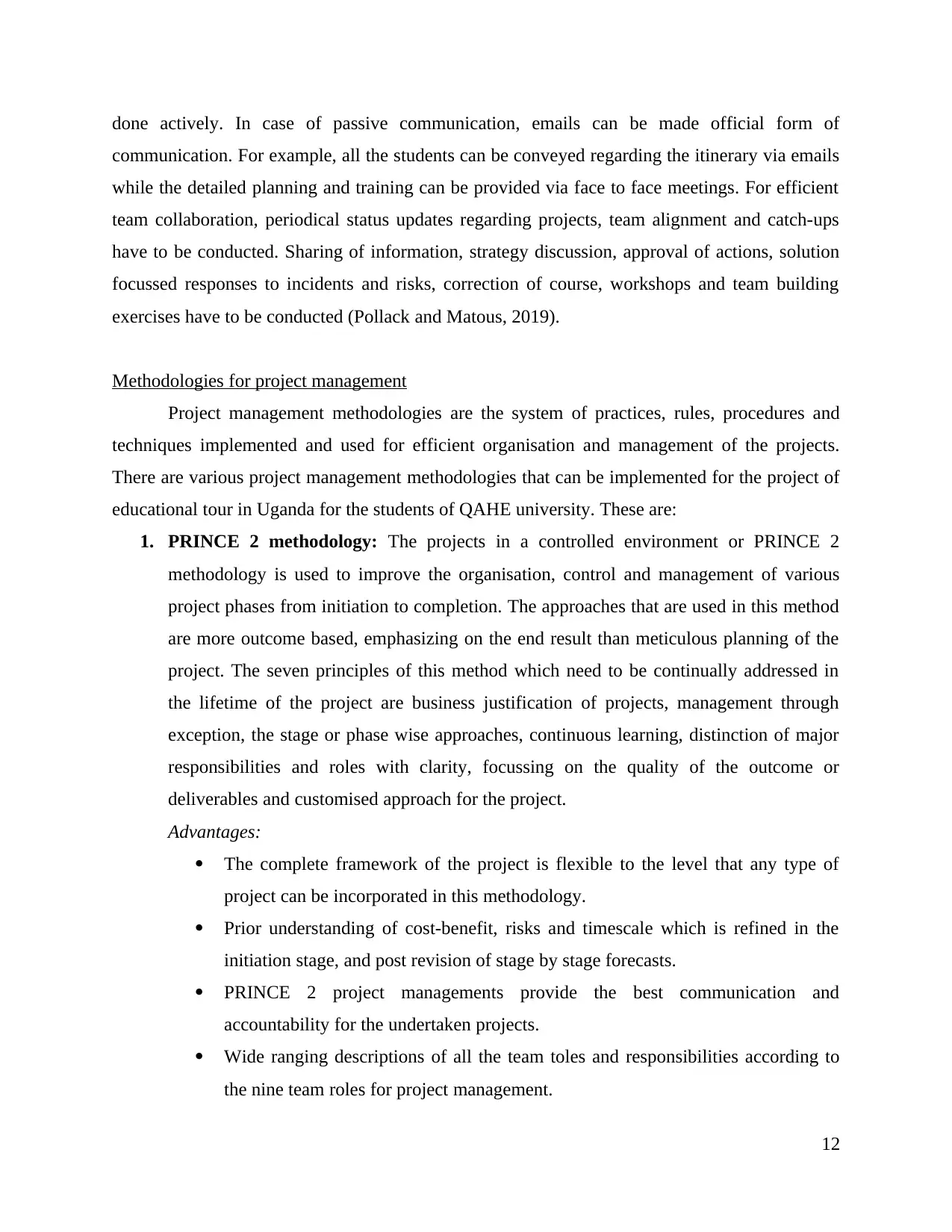
done actively. In case of passive communication, emails can be made official form of
communication. For example, all the students can be conveyed regarding the itinerary via emails
while the detailed planning and training can be provided via face to face meetings. For efficient
team collaboration, periodical status updates regarding projects, team alignment and catch-ups
have to be conducted. Sharing of information, strategy discussion, approval of actions, solution
focussed responses to incidents and risks, correction of course, workshops and team building
exercises have to be conducted (Pollack and Matous, 2019).
Methodologies for project management
Project management methodologies are the system of practices, rules, procedures and
techniques implemented and used for efficient organisation and management of the projects.
There are various project management methodologies that can be implemented for the project of
educational tour in Uganda for the students of QAHE university. These are:
1. PRINCE 2 methodology: The projects in a controlled environment or PRINCE 2
methodology is used to improve the organisation, control and management of various
project phases from initiation to completion. The approaches that are used in this method
are more outcome based, emphasizing on the end result than meticulous planning of the
project. The seven principles of this method which need to be continually addressed in
the lifetime of the project are business justification of projects, management through
exception, the stage or phase wise approaches, continuous learning, distinction of major
responsibilities and roles with clarity, focussing on the quality of the outcome or
deliverables and customised approach for the project.
Advantages:
The complete framework of the project is flexible to the level that any type of
project can be incorporated in this methodology.
Prior understanding of cost-benefit, risks and timescale which is refined in the
initiation stage, and post revision of stage by stage forecasts.
PRINCE 2 project managements provide the best communication and
accountability for the undertaken projects.
Wide ranging descriptions of all the team toles and responsibilities according to
the nine team roles for project management.
12
communication. For example, all the students can be conveyed regarding the itinerary via emails
while the detailed planning and training can be provided via face to face meetings. For efficient
team collaboration, periodical status updates regarding projects, team alignment and catch-ups
have to be conducted. Sharing of information, strategy discussion, approval of actions, solution
focussed responses to incidents and risks, correction of course, workshops and team building
exercises have to be conducted (Pollack and Matous, 2019).
Methodologies for project management
Project management methodologies are the system of practices, rules, procedures and
techniques implemented and used for efficient organisation and management of the projects.
There are various project management methodologies that can be implemented for the project of
educational tour in Uganda for the students of QAHE university. These are:
1. PRINCE 2 methodology: The projects in a controlled environment or PRINCE 2
methodology is used to improve the organisation, control and management of various
project phases from initiation to completion. The approaches that are used in this method
are more outcome based, emphasizing on the end result than meticulous planning of the
project. The seven principles of this method which need to be continually addressed in
the lifetime of the project are business justification of projects, management through
exception, the stage or phase wise approaches, continuous learning, distinction of major
responsibilities and roles with clarity, focussing on the quality of the outcome or
deliverables and customised approach for the project.
Advantages:
The complete framework of the project is flexible to the level that any type of
project can be incorporated in this methodology.
Prior understanding of cost-benefit, risks and timescale which is refined in the
initiation stage, and post revision of stage by stage forecasts.
PRINCE 2 project managements provide the best communication and
accountability for the undertaken projects.
Wide ranging descriptions of all the team toles and responsibilities according to
the nine team roles for project management.
12
⊘ This is a preview!⊘
Do you want full access?
Subscribe today to unlock all pages.

Trusted by 1+ million students worldwide
1 out of 16
Related Documents
Your All-in-One AI-Powered Toolkit for Academic Success.
+13062052269
info@desklib.com
Available 24*7 on WhatsApp / Email
![[object Object]](/_next/static/media/star-bottom.7253800d.svg)
Unlock your academic potential
Copyright © 2020–2025 A2Z Services. All Rights Reserved. Developed and managed by ZUCOL.




